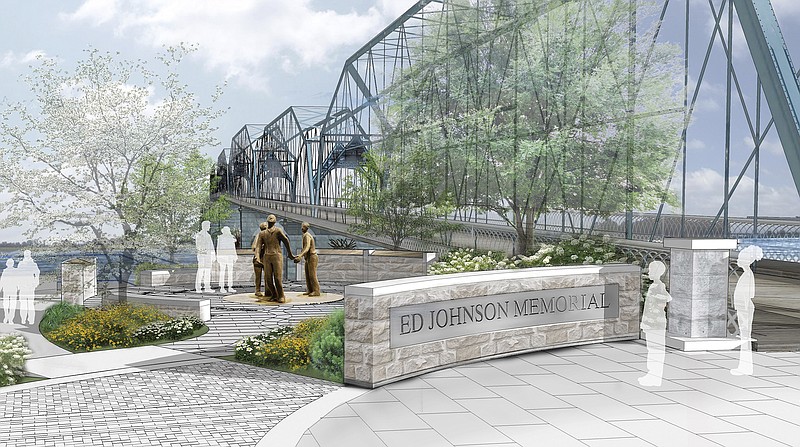We talk a lot about Chattanooga's Civil War history, its American Indian history and its industrial history.
We talk little about our city's African-American history, and even less of its civil rights history.
That's a shame, because our city is rich with black history, just as it is rich with those other histories. And it usually is only through remembrance and talking that true unity occurs.
We have some upcoming opportunities to make amends.
The proposed Ed Johnson Memorial planned for construction at the south side to the Walnut Street Bridge offers an excellent start. Johnson, who was black, was wrongly accused of raping a white woman, convicted in court despite a lack of credible evidence and sentenced in 1906 to be hanged. Two black attorneys, Noah Parden and Styles Hutchens, took the case to the U.S. Supreme Court, which granted a stay of execution. But an angry mob here stormed the jail and lynched Johnson on the bridge. A newspaper account from the time quoted Johnson as saying just before he was killed, "I'm ready to die, but I never done it."
A Chattanooga group of citizens is raising money for the memorial, which will honor not only Johnson, but also the two black attorneys who took his case to the Supreme Court, as well as three other victims lynched in Hamilton County.
Second, another group of Chattanoogans, with the help of National Park Partners, are planning a downtown Chattanooga walking tour of African-American historic sites on Wednesday to help local residents better grasp our history. The tour is patterned after those of Chattanooga history buff and attorney Maury Nicely, who has researched and written a book titled, "Chattanooga Walking Tour and Historic Guide."
Nicely says many of our important civil rights historic sites have already disappeared - the victims of progress.
S.H. Kress, the "five-and-dime" store on Market Street where Howard High School students staged a sit-in at the white section of the store's lunch counter on Feb. 19, 1960, is now part of Miller Plaza. A plaque marks the spot.
Chattanooga's Carnegie Library building at Eighth and Georgia also has a civil rights story, Nicely says. Built with a $50,000 gift from Pittsburgh steel magnate Andrew Carnegie, it opened in 1905. But it almost didn't.
Then-Chattanoogans wanted to designate a side door as the black entrance. Carnegie balked and said he would not build a segregated library. Chattanooga's response was: Then don't build it. Carnegie decided to build the library anyway "to better educate us hillbillies," Nicely said.
Like Memphis' Beale Street, what's left of "the Big Nine on Ninth Street, now known as Martin Luther King Jr. Boulevard, could still be used to better explain Chattanooga's amazing jazz history - and not just through the story of young Bessie Smith, singing for coins.
From the 1930s through the 1960s, the M.L.King stretch between Memo's Grill at the corner of Foster Street and the Peeples Street overpass used to be Chattanooga's epicenter of black music, fun, dancing and food. At least six nightclubs hosted world-famous stars such as Cab Calloway, Muddy Waters, Howlin' Wolf, Ray Charles and Count Basie. Fred Cash and Sam Gooden got their start on the Big Nine, then later helped create the Impressions with Curtis Mayfield in Chicago.
What we know today as the Terminal Brewhouse began life as the Stong building, home to speakeasies during Prohibition. In the early 1940s, Chester Davis, a porter at the nearby Terminal Station (now the Choo Choo) bought the Stong building with his saved tips, becoming one of our city's first black business owners.
And the Freight Depot, across from Warehouse Row, is where the young men who came to be known as "the Scottsboro Boys" hopped a train to Alabama in 1931. The rest is history. The nine African-American teenagers, ages 13 to 20, were later falsely accused in Alabama of raping two white women on the train, though there was no evidence of rape and one of the women said they made up the story. The accused men were tried several times, and spent years in jail before being pardoned - some posthumously. A landmark set of legal rulings, from dealing with racism to the right to a fair trial, came from the incident.
Last year, U.S. Sen. Lamar Alexander, R-Tenn., co-sponsored bipartisan legislation to establish the African-American Civil Rights Network. Facilitated by the National Park Service, the network would form preservation and interpretation partnerships with existing federal, state, local and privately owned sites found to be significant to the civil rights struggle. President Trump signed the bill into law in January, and just this month Secretary of Interior Ryan Zinke designated the Mississippi home of slain civil rights leader Medgar Evers as an official African-American Civil Rights Network site. The Park Service plans eventually to post online guidelines for site nominations.
Already, Tennessee has 10 tourism stops along the newly launched U.S. Civil Rights Trail - all in the cities of Memphis, Nashville and Clinton (home of the first desegregated public high school in the South.)
Other than a handful of plaques and the Bessie Smith Cultural Center, we currently make little of the artifacts of Chattanooga's civil rights history.
We can - and should - change that.
